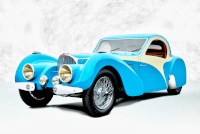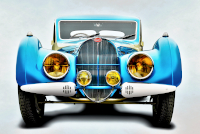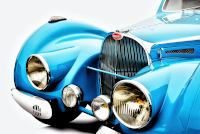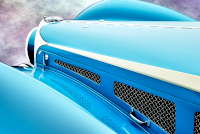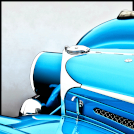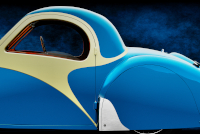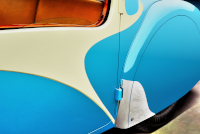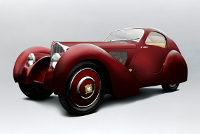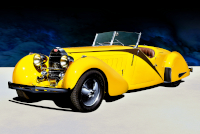Location:
Pebble Beach Concours d'Elegance, 2009
Owner: Ray Scherr | Westlake Village, California
Prologue:
Note that #57523 sold to a new owner in 2013.
It's taken more than a decade since I photographed chassis #57523 to publish this profile, but I'm glad I waited because, with time and new techniques, I could bring the images together the way I first envisioned. I don't even mind the granularity of the old sensor—the finish still works out nicely thanks to Monterey's cast of even, grey light. For me, this car is connected to the Type 51 Coupe by Dubos; they sat side-by-side in the winners circle at Pebble Beach, the Type 57 having won the French Cup. Like the Type 51, this Type 57 was also once part of the Nethercutt Collection. Both have changed color a bit, too. For #57523, I'm saddened to know that the lovely turquoise and cream presentation turned out to be short-lived. The black livery is stunning, though of a completely different personality. Still, as the car now lives in Europe, I'm fortunate just to have seen it and snapped a few photos.
- - - - - - - - - -
► Image Source: Nikon D200 (10.2 MP)
References:
- Conway, H.G. "Bugatti: Le pur-sang des automobiles" Third Edition, G.T. Foulis & Co. Ltd., Sparkford, Yeovil, Somerset, England. 1974, page 259, 262, 267, 270, 278, 280
- Conway, H.G. "Profile No. 41: The Type 57 Bugatti" from Classic Cars in Profile, Volume 2, Doubleday and Company, Inc., Garden City, NY, 1967. First published by Profile Publications Limited, Leatherhead, Surrey, England, 1967.
- Price, Barrie. "Bugatti 57, The Last French Bugatti" Veloce Publishing, Poundbury, UK. 1992 page 6-9
- Supercars.net: A nice overview with a sampling of various SC examples, including #57523.
- Gooding & Company: The auction posting for #57523, depicting the car in its present all-black livery.
- Wikipedia: Good information on Type 57 lineage.
- UltimateCarPage: The uber-site's entry for #57523, with photographs from Villa d'Este (2016) and Pebble Beach (2009). Work by Wouter Melissen, December 23, 2009.
Chassis #57523 has since returned to its original black-on-black livery, so it's prudent to note that what you see here only existed for a short time between 2007 and 2013. The car is a very well documented example, and therefore a reasonably good candidate for restoration to its original configuration. And so we've stumbled upon one of those strange classic car scenarios in which it would be nice for both versions to survive. As of writing, the car has also returned to Europe, which means we were fortunate to spot it during its stay here in North America.
A project developed under the guidance of young Jean Bugatti, the Type 57 S gained a sleek profile through numerous mechanical advances. Bugatti modified the Type 57 frame, using lighter C-channel frame rails, while passing the rear live-axle tubes through oval holes, giving name to the model's 'Surbaissé' designation. Up front, the vee-shaped radiator sits deeper in the chassis, aligning with the block, which itself sits lower thanks to dry-sump lubrication fed by an external oil reservoir. Befitting a sports version, the Type 57 S naturally uses a shorter wheelbase than the standard Type 57, reduced by 320 mm to 2,980 mm.
Mechanical differences between the Type 57 S and Type 57 begin with a lighter crankcase and higher compression pistons. When supercharged, the twin-rotor compressor spins at 1.17 times motor speed, providing 5 to 6 p.s.i. of pressure. Paired to the compressor, the camshaft in either a Type 57 C or Type 57 SC is the same as the standard Type 57, but with different valve clearance to tweak the timing. As can be said for blown classic-era cars from Bentley and Mercedes-Benz, the benefit affects acceleration and power throughout the range, adding slightly to the top-end speed. To transmit power (about 200 bhp in a Type 57 S or SC), the car uses a dual-plate clutch.
Much has been written about the Type 57 suspension, which is a charming and anachronistic engineering feature. The Type 57 prototype built in 1933, (#57100, scrapped by the factory as of 1936), used an independent front suspension developed by Jean Bugatti and Meo Costantini. So smooth was the driving characteristic that the staff christened the car, "Green Chartreuse." However, Ettore rejected the idea in favor of his tried-and-true solid front axle, after which the Type 57 entered production with a two-piece variant, the idea being to allow independent axle rotation. Due to poor ride quality, early Type 57 cars returned to the factory and the two halves were braised, joining them back together in one solid piece. For the sportier Type 57 S, the split solid axle reappeared, but with the addition of torque reaction rods to control twist. The Type 57 S also added de Ram shock absorbers, advanced for the time, which used hydraulically loaded friction damping "arranged so that the pumping action of movement loads the friction plates proportionately to speed." So in a round-about way, the Type 57 S and SC received a more advanced suspension than the standard Bugatti car, but only through expensive comprise.
The push-pull between Ettore and his son Jean, who was just 23 at the time of the Type 57's development, stems in part from the two men focusing on vastly different projects. At the time of the Type 57's inception, Ettore (and much of the staff) devoted their energy to fulfilling orders for a railcar concept, the motors based on the amazing, but instantly obsolete Type 41 Royale. The railcar project would not prove successful, but, somewhat subversively, left Jean to his own devices. Jean contributed many advances to the Type 57 while also initiating the Type 59 Grand Prix project. However much father and son were invested in what the other was doing, this period represented the flourish of beauty and ingenuity for which Bugatti would become known over the course of the century.
Of some 725 Type 57 cars, little over 40 were Type 57 S versions. Of those, most Type 57 SC cars are upgraded Type 57 S versions. This scenario was rather identical to the Duesenberg Model SJ, in which Model J owners either returned to the factory or used factory stock to upgrade their cars to the supercharged version. Both Duesenberg and Bugatti would have figured the standard cars sufficiently powerful for the public, and only produced blown versions from the factory in rare cases. One difference to note, however, Bugatti used the Type 57 C and Type 57 SC designations in period for its supercharged cars, whereas Duesenberg owners retroactively applied the 'S' to the Model J name.
Motor: 3,257 cc straight 8-cylinder, cast iron block and head | 72 mm x 100 mm | 8.5:1 compression
As well as a higher compression ratio, the SC motor is a dry sump unit, and the crankcase is lighter.
Valvetrain: DOHC, 2 valves per cylinder
While the camshafts are the same as the standard Type 57 motor, the valve clearance is slightly different, and therefore the timing changes as well compared to the base car.
Aspiration: single Stromberg UUR2 carburetor with a twin-rotor, Roots-type supercharger, and Scintilla Vertex magneto
The supercharger runs at 1.17x motor speed and produces 5 to 6 p.s.i.
Power: 200 bhp @ 5,500 rpm
Drivetrain: 4-speed manual gearbox, rear-wheel drive
Type 57 S and 57 SC models use a double-plate clutch to handle the extra power.
Front Suspension: beam axle with semi-elliptic leafsprings and de Ram telescopic shock absorbers
Conway notes that the front axle articulates in halves "with a rotating collar in the centre with appropriate brake torque radius rods." Also described as 'torque reaction rods,' these braces prevent axle twist.
Conway also explains that the de Ram units use "hydraulically loaded friction damping so arranged that the pumping action of movement loads the friction plates proportionately to speed."
Rear Suspension: live axle with reversed quarter-elliptic leafsprings and de Ram telescopic shock absorbers
The rear axle passes through the frame rails, hence the 'S' (surbaissé) in the model nomenclature.
Architecture: steel, cross-braced frame
Kerb Weight: 1,550 kg (3,417 lbs)
Wheelbase: 2,980 mm (117.3 inches)
Top Speed: 201 km/h (125 mph)
Etymology:
Bugatti numbering follows sequential factory projects. Mechanically, the Type 57 succeeded the Type 49, which exited the year of the Type 57's introduction, 1934. The Type 57 S came along in 1936. The 'S' designation means 'surbaissé,' or 'lowered,' and not 'sport' as most would assume. In the classic era, and even for some time previous, a lowered chassis meant the axles were either fitted through the frame, or suspended above the frame. The 'C' designation means 'compressor,' denoting the addition of a supercharger. The 'SC' designation is, obviously, a lowered, supercharged car.
Figures:
While in production for the better part of the decade, Bugatti produced a shade over 700 Type 57 examples. Of these, a hair more than 40 are SC versions. Most SC cars began life as a Type 57 S, with a supercharger added later in life, often by the factory.
Value:
Chassis #57523 sold at the Gooding & Co. Pebble Beach auction in 2022 for $10,345,000. The car previously sold at the Gooding & Co. Pebble Beach auction in 2013 for $8,745,000.
Turqouise and Ivory: Changing Liveries on Bugatti Type 57 SC #57523
As noted, this car only existed as shown from about 2007 to 2013. Returning the car to its original black-on-black livery makes some sense, given the car's unbroken history. With its disc wheels and svelte level of polish, one could place #57523 next to Ralph Lauren's Type 57 SC Atlantic, #57591, to compare the notch-back styling of the Atalante against the fast-back styling of the Atlantic. Still, it's lamentable that the turquoise and cream livery no longer exists. (The same trend turned the amazing Delahaye 135 MS Competition Court Coupe by Figoni et Falaschi, chassis #46576, from the two-tone metallic blue livery it enjoyed following restoration by Phil Hill, to its contemporary gloss black.) As shown, our Bugatti appeared as lively counterpart to chassis #57551, a two-tone yellow and ochre car. These two cars appeared alongside each other on at least one occasion, representing the most dashing and colorful of the Type 57 line.
Body Style: The Notchback Bugatti Atalante
Chassis #57523 is one of the few with the more complicated French sweeps down the flank and around the hood. Of known examples, chassis #57562 also shares this body style, a black and yellow car. The majority of Atalante bodies use a graceful sweep along the flanks down to the seam where the rear skirts meet the doors. However, this body style here includes an opposing curve that returns up along the door, framing the window in contrasting color and creating a thin belt around the back of the hood. Note that Bugatti also fitted the Atalante body style to the standard Type 57, and so this same variation also appears on chassis #57624, a Type 57 C. However, with its larger proportions, that car does not offer the same delicate sweetness of the Type 57 SC.
Massive Scintilla headlamps protrude from the front, more impressive in this regard than even the amazing Type 57 SC Atlantic cars, as these broad barrels emphasize the cuts and channels in the fascia design. These flat-front headlamps are not only larger than most, but quite different from the bell-shaped headlamps used on most other Type 57 cars. Our chassis also retains perhaps the most elegant of front guards, two opposing chrome teardrops. A set of Marchal driving lights adds to the color, without detracting much from the fascia's complex shapes.
As with most of SC cars, the bonnet includes a set of three screened vents on each side. Most SC cars use some form of kickplate on the leading edge of the rear skirt, and here, #57523 shares the same pattern as many other examples, with an elegant curve along the front edge of the wheel skirt. Marker lights sit upon the front arches, common to many examples, and the flared door handle is one of a few variations, the other common fixture being straight.
The rear skirts wrap around the back and under the continental spare in a seamless cradle, with small, round tail lights fit directly into the body. Like most of the car's strange mix of angularity and fluidity, the tail expresses a hand-drawn quality. Up top, the shape of the hood is pert, and almost English. The rear split-windows make only marginal sense, but do seem to match the bonnet vents, not too big to distract from the shape. (While a better view of the tail would have been lovely, I'm fortunate to have recorded this much as it it.)
Vee Radiator: The Chausson Unit
Bugatti did not fabricate the chromium-plated radiator, sending an outline to Chausson in Paris, who completed the design and construction. Even so, this outsourced component is central to the Type 57's darting appearance, a nod to the earlier Mercedes-Benz SSK. As built by Chausson, the radiator grille includes vent slats similar to period Talbot-Lago cars. The scalloped shape matches the body panel dart at the front, and ends in a central point at the base, which is best displayed in versions such as ours, without a continuous guard to block the view. While the radiator is neatly integrated into the body along the bonnet, it is also nearly hanged on the edge of the frame. A single crossmember between the fender arches, a stout bar connecting the front chassis rails, and the elegant solid axle all weave in front of and behind the great chrome crest. Few classics created such a whimsical home in which to nestle such a magnificent grille.
Atalante Design: Cohesion of the Bugatti Atalante Design
Once you begin to pull apart the contrast between the long, sleek lines of the body panels and almost crude, cut-out shapes of the windscreen and doors, it seems rather amazing that the whole composition works so well. But then I think this is the advantage of the Type 57 SC against Figoni et Falaschi's Talbot-Lago T-150 C SS: The latter is constant curves, which is difficult for the eye to follow; it is a teardrop, or an egg, with the terminus of each line hiding around the crest of each curve. The Bugatti is here-and-there in comparison, with complexity separated enough to digest more easily. I believe we can see everything that's happening in the design more clearly. And so the car delivers these wonderfully massive headlamps on projected barrels, a vee radiator exposed to the front axle below it, deep channels in the front arches, extravagant French curves down the flanks, and a lovely, wrap-around tail. And we think little of it, because it makes sense.
In comparison, the T-150 C SS offers its shape more than its components. And, with the exception of a fine dorsal fin, those components can appear a bit more tacked-on. Going one step further, we can therefore say that this composite approach to the Atalante design maintains the car's identity as a mechanical artifact, much like all Bugatti cars, whereas the Talbot-Lago appears more like a solid metal sculpture. I prefer the mechanical artifact. The proportions work. Delicacy and lightness run through the design, helped by the wire wheels and toe-in camber, punctuated by a long, straight bonnet. And while there are other designs that evoke the fluidity of a Figoni et Falaschi teardrop, a Bugatti design always maintains its own character.
Last Updated: Mar 26, 2025

